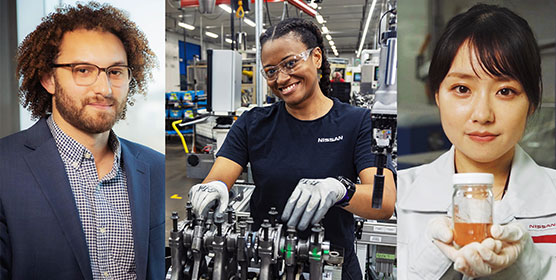Legend 06: Hailed as a ‘Pioneer’, Kyoko Shimada

Kyoko Shimada
Kyoko Shimada grew up in Tokyo. She joined Nissan Motor as a designer in 1967 after graduating from the Japan Women’s University with a major in architecture. She worked in various fields, including product planning, a corporate identity project, sales planning, public relations, corporate citizenship activities, and corporate social responsibility (CSR).
After she retired in 2005, she served as a director, secretary general, and part-time lecturer at the Japan Women’s University. Since September 2010, she has been the representative director, director general of the Yokohama Arts Foundation. She has also held various other positions in society, including serving as a member of the Central Council for Education of the Ministry of Education, the chairperson of the CSR Committee at Keidanren, and a director of a nonprofit organisation, among others. As a pioneer of female participation not only inside Nissan but also in Japanese society, Kyoko Shimada continues to be very active and to attract attention for her influence on society.
What Nissan's first female designer felt
During its 80-year history of progress and development, Nissan has undergone a number of major transformations, including among others the hiring of female designers ahead of the demands of the times so as to utilise their unique capabilities, the execution of a global brand strategy based on corporate identity initiatives, and the transformation of sales activities from door-to-door sales to sales at dealer showrooms.
Kyoko Shimada was one of the key players taking on the challenges involved in these far-from-minor reforms and often she served as the leader of these efforts. Having read this far, many readers may be surprised by this and surprise can be considered a natural response.
After all, the stage was an automaker and even though Nissan has always been characterised by a relatively liberal and pliable corporate culture, it was undisputedly a male-dominated company, as was the case with other automakers around the world. It is fair to say that Kyoko Shimada’s career overlaps with the history of challenges at Nissan and with the history of the advance of women in the automobile industry.
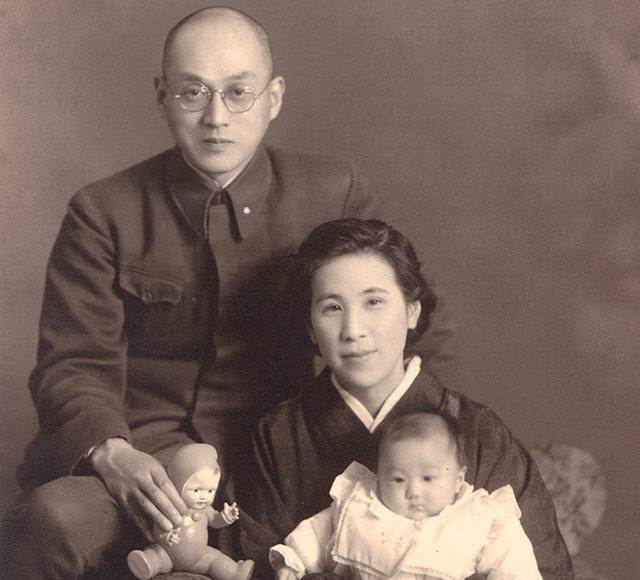
Three months after birth with her parents, at the capital of Manchuria (May, 1945).
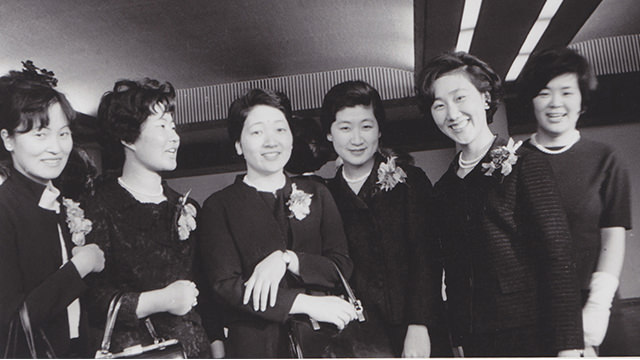
At a graduation ceremony of Japan Women’s University with her friends of architecture subject (March, 1967. Shimada, 2nd person from right side).
‘To
tell
you
the
truth,
when
I
joined
Nissan,
I
thought
I’d
only
work
there
for
two
or
three
years.
I
meant
for
it
to
be
a
temporary
job,’
she
confessed.
Since
we
are
very
familiar
with
her
role
as
a
pioneer
in
subsequent
years,
these
words
of
hers
are
quite
surprising.
But
her
determination
to
be
true
to
herself
was
the
driving
force
behind
her
outstanding
career,
which
in
turn
contributed
greatly
to
the
development
of
Nissan
into
a
global
company.
She was born in northern China six months before the end of World War II and grew up in Tokyo, where she studied architecture at the Japan Women’s University. Despite her major, she decided to work at Nissan as she thought ‘it wouldn’t be a bad idea to experience a different world before becoming an architect.’ She was employed as a designer.
This was in 1967, which was still 19 years before the Equal Employment Opportunity Act for Men and Women took effect in Japan and a time when women’s active participation in all areas of society had yet to take root in Japan. Shimada recalls, ‘There wasn’t a single female designer at any of the automakers in Japan at that time, but Nissan recognised ahead of other car companies that it was necessary to get a woman’s input into car design because every household was about to own a car.’
Shimada started off her career as the first female designer in the Japanese auto industry.
If there is no precedent, why not make one?
It was a time when the car was a symbol of Japan’s post-war reconstruction and high economic growth, as well as an object of desire among the public. Most of her co-workers, including engineers and peers in other departments, not to mention a staff of around 50 designers, were men who were well versed in automobiles. Despite finding herself in this environment, Shimada was not particularly interested in cars as advanced machinery operated by drivers.
Instead, or rather, because of that, she had unique strengths that her male colleagues lacked. ‘Living space’ is how she saw a car. It was a living space that also had a function of mobility, a space for not only the driver but also the passengers in the front and rear seats, as well as other elements, such as contrast and harmonisation with the outside world. Shimada also considered a car to be a space where the users themselves could express their own lifestyles and identities.
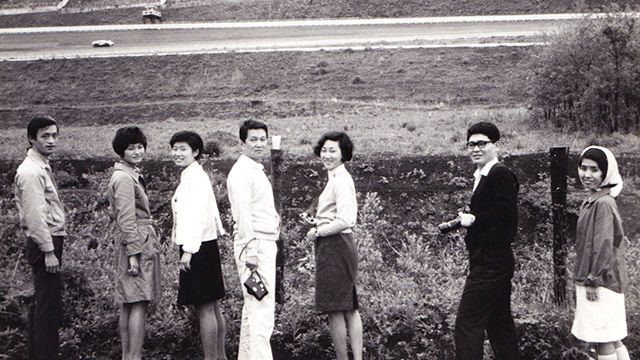

Shimada
was
assigned
to
work
on
colours
and
interior
designs
for
passenger
cars.
Trying
to
get
some
inspiration,
she
browsed
around
department
stores
to
get
a
feel
for
what
was
in
for
not
only
women’s
but
also
men’s
fashion
and
colours
and
visited
various
places
to
see
sophisticated
and
bijou
buildings
and
furniture.
She
proposed
chic
blues,
browns
and
whites
at
a
time
when
the
exteriors
of
official
luxury
vehicles
were
all
black,
casually
challenging
stereotypes
that
nobody
had
ever
before
thought
of
questioning.
Looking back on that time, Shimada said, ‘I often hear people saying “because there’s no precedent.” But having no precedent can’t be an excuse of not doing something differently. If there is no precedent, why not make one? Once there is a case, others will follow in a natural way.’
She feels that her way of approaching things might have been influenced by her training in the creative field of architecture, as well as her own experiences at Nissan. But that’s not all. She added, ‘Ever since I was a little girl, I was never obsessed with winning competitions. Instead, I always thought that I would do something that only I could do, even while always being aware of the role that was expected of me.’
As she devoted herself to her various assignments, she formulated the idea of ‘getting more involved in car development from a broader perspective.’ In time she was transferred to the Design and Development Division. For her, who had no expertise in this area, it was a major career change that amounted to starting over from scratch. It was indeed challenging. By then, seven years has passed since she had joined Nissan, which she had considered a temporary arrangement.
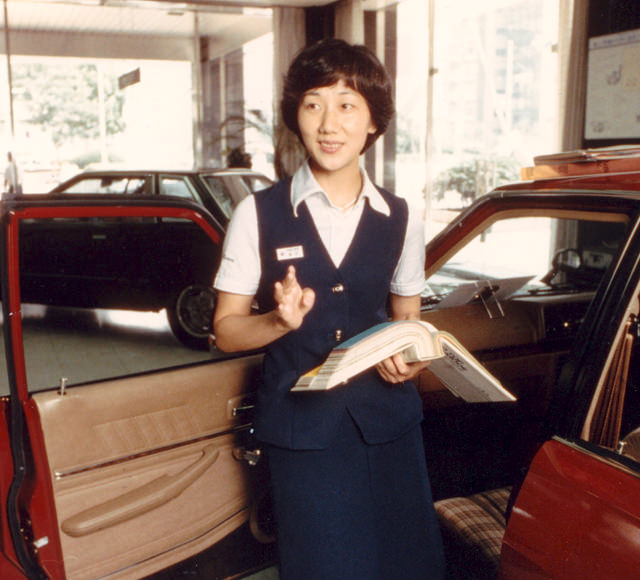
Enriched experiences in the totally new field of the Design and Development Division following her first assignment at the Design Department (at the Head Office Showroom).
In the vanguard of brand strategy execution
In 1974, her eighth year at Nissan, Shimada was transferred to the Design and Development Division, where she devised new products based on the findings of market research. There was one thing in particular that she had noticed while watching generations of Nissan products roll by as part of her work. The logos and badges were all different from one model to the next and the colours and typographies of dealer signboards, product leaflets, and product brochures were all different. She began to ask herself, ‘What is Nissan-ness?’ ‘Perhaps it’s time to consider a global brand strategy for a new era?’

On a business trip to New York, the first overseas business trip by a female employee at the time.

In 1980, she was given an opportunity to go overseas to learn more about this issue. Soon after, in 1981, she was named one of five members of a corporate identity (CI) project team that would report directly to the president of the company. The project’s mission was to complete the development and preparation of a plan and manual to promote the CI initiative in two years. She was selected to be in the vanguard of this major transformation. After the project team was disbanded, Shimada was transferred to the Communication Department to continue working on the global deployment and execution of the CI plan.
‘To me, a unique feature of Nissan-ness is a willingness to take on challenges. Because of that, Nissan encourages freewheeling thinking and can build forward-looking cars that respond to the needs of a new era. The CI initiative provided a great opportunity to embody this challenging spirit.’
In later years, under the leadership of CEO Carlos Ghosn, her experience took her to the mission of developing VI (Visual Identity) as part of the company’s global brand strategy. During her time in the Communication Department, Shimada was involved in image creation strategy and in 1984 she was named the first female manager at Nissan. Moving to the Business Planning Department in 1988, also as a manager, she took charge of the renewal of dealer showrooms nationwide. This signalled a major shift in sales style from traditional door-to-door sales to new showroom-based sales activities.
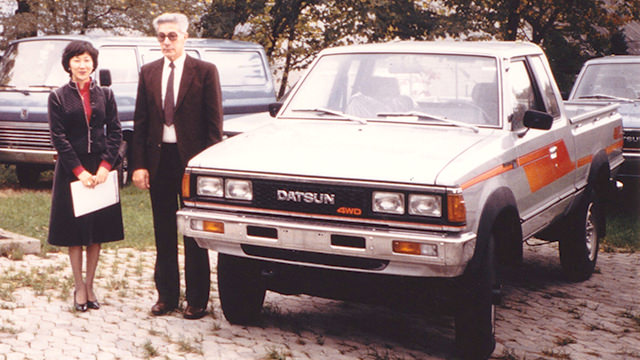
She visited many overseas facilities, mainly in Europe and North America, to promote the global deployment of the CI initiative.
‘Conventional dealers that mainly sold cars through door-to-door visits were just displaying cars and as such were far from generating a welcoming atmosphere for customers to simply drop in. I thought that dealers should be transformed to accommodate the needs of family users and to welcome female drivers, whose numbers were rising sharply from the early 1980s. My ideas were translated into the establishment of casual café-like spaces and children’s play areas, as well as the renovation of bathrooms into clean, comfortable spaces. Feminine wisdom and a designer’s perspective helped me greatly.’
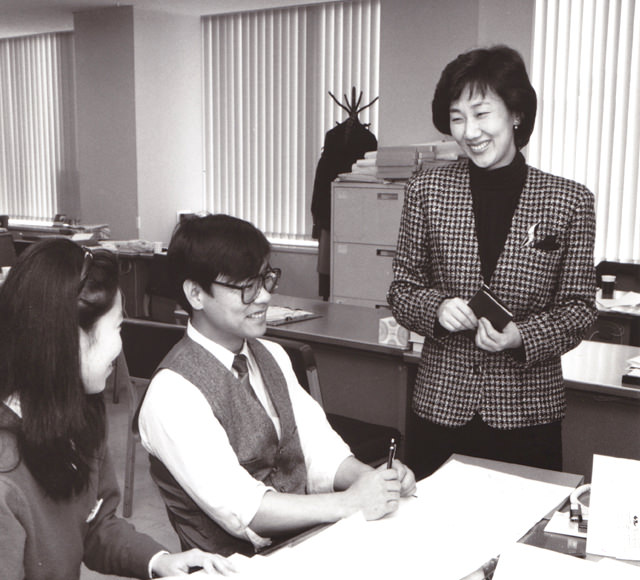
In 1991, Shimada was put in charge of corporate citizenship activities. Realising the importance of such activities, many companies today conduct related programs constantly and systematically as an essential part of their business strategies. Back then, however, few businesses in Japan considered such social programmes a valuable part of their social roles and promoted them accordingly. Nissan was the leader among automakers in this field. Some argued the necessity of such programmes because the Japanese economy was then facing extreme difficulties and the business environment was quite daunting, but Yutaka Kume, Nissan’s president at the time strongly believed that corporate citizenship activities were critical business issues for every company and intimately connected with a company’s raison d’être in society. Under his leadership, a dedicated section was established at Nissan and Shimada was put in charge of it to ensure its success.
‘In a world where global society and Japanese society are constantly changing, we can see that societies based on monolithic value systems are fragile. I believe that a society that accepts different value systems and a society where the interaction of diverse values takes place can serve as an incubator for powerful forces that will lead to the building of new societies.’
I like working with people
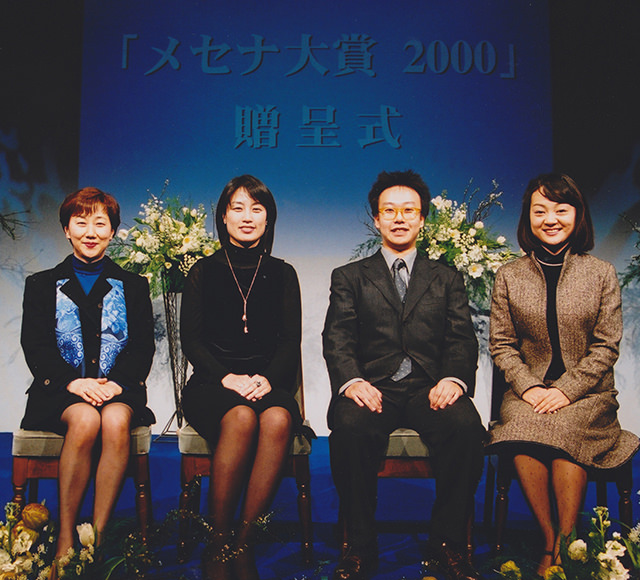
Awarded the Japan Mécénat Award by the Association for Corporate Support of the Arts, which honours corporations and corporate foundations for outstanding arts support (Shimada, 1st person from left side).
A society encompasses too many problems for a single company to cope with. In order to define a clear direction and translate it into a business strategy, Shimada developed a course of action and adopted criteria for choosing an area of activities and groups to support.
One
of
the
company’s
unique
corporate
citizenship
activities
is
the
Nissan-NPO
Learning
Scholarship
Programme,
under
which
Nissan
recruits
and
selects
students
to
work
at
NPOs
and
provides
them
with
scholarships
commensurate
with
their
internship
activities.
‘This
programme
was
launched
in
1998
in
the
hope
of
providing
young
people
with
an
opportunity
to
engage
in
intellectual
labour.’
Referring
to
it
as
‘investing
in
the
young’,
CEO
Ghosn
himself
handed
out
certificates
to
the
participants
each
year.
Another
initiative
called
the
Nissan
Children’s
Storybook
and
Picture
Book
Grand
Prix
has
entered
its
29th
consecutive
year,
serving
as
a
gateway
to
success
for
young
authors.
Among
other
examples
of
Shimada’s
work
and
expansion
of
corporate
initiatives,
she
promoted
taking
diverse
ideas
from
society
into
the
company
and
encouraged
various
volunteer
activities
among
employees
by
providing
corporate
support.
In
2003,
when
the
CSR
concept
was
not
yet
widely
recognised
in
Japan,
Shimada
was
ordered
by
CEO
Ghosn
to
establish
a
project
team
to
compile
and
issue
a
sustainability
report.
As
the
project
leader,
she
set
up
the
Sustainability
Group
within
the
Public
Relations
Department
and
it
became
the
foundation
of
today’s
CSR
initiatives
at
Nissan.
‘In fact, during the course of compiling the report, I came to believe that CSR could be a means of corporate governance. I see sustainability as a broader concept. Sustainability can help us review and re-evaluate all corporate activities from the viewpoints of all stakeholders and help us encourage employees to develop a social perspective. Compiling the report led to the identification of common ground shared by the company and society, which can secure sustainable growth. I think that a constant dialogue with society can make the company an organisation that is always learning.’
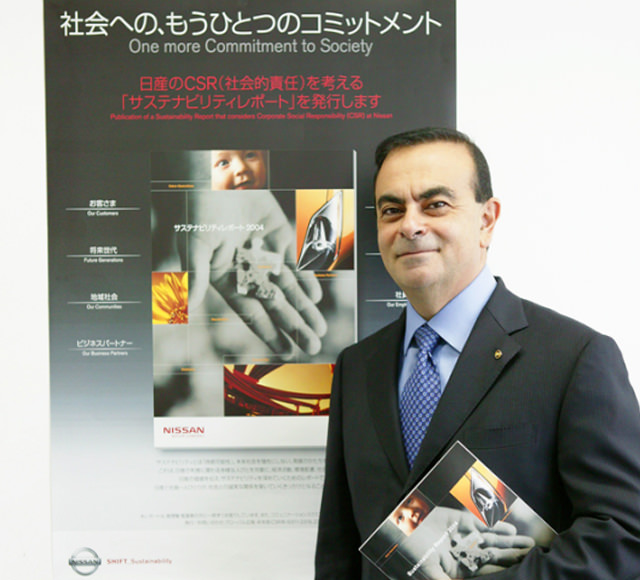
The
key
words
for
the
corporate
citizenship
activities
and
CSR
initiatives
to
which
Shimada
devoted
herself
were
‘diversity’
and
‘a
learning
organisation’.
They
are
key
words
that
reflect
the
present
times,
that
symbolise
Nissan
constantly
taking
on
new
challenges,
and
that
mirror
the
personality
of
Kyoko
Shimada.
‘Because
I
myself
do
not
have
particularly
high
competencies,
I
cannot
move
forward
without
support
from
experts
around
me.
From
the
time
that
I
joined
Nissan
until
I
retired,
I
kept
learning
from
others.
‘My days at Nissan made me realise that I like to work with people. When different personalities get together, they teach me things that I was not aware of and I often have ideas I could not have come up with on my own. I am also impressed quite often by the different thinking and feelings of others.’
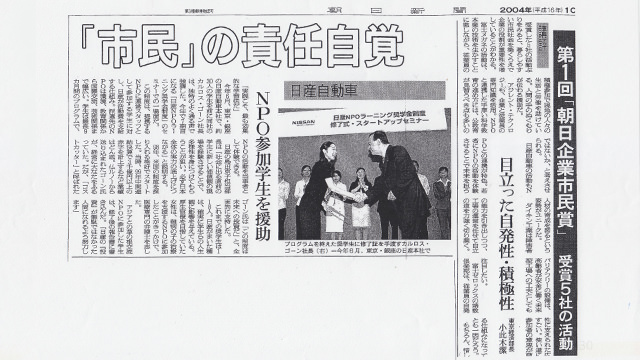
A newspaper article covering the awarding of the First Asahi Corporate Citizen Award.
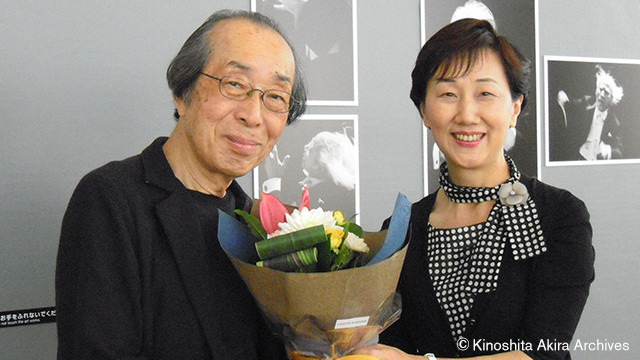
She spent 38 years at the company she joined with the idea that it would only be a temporary arrangement, staying until she reached retirement age. She pursued her assignments quietly and steadily and along the way, she established a record of achievements that invariably are qualified with such words as ‘the first woman’ or ‘the only woman’.
‘Of course I got frustrated. But when I think about it now, I know that I gained more than I lost. For instance, I was given a chance to try something new because they thought “a woman might bring a different sense and different abilities from a man”. Creating a precedent by myself was an exciting experience.’
Kyoko Shimada was always a pioneer, not only at Nissan but also in the Japanese automobile industry. Since retiring from Nissan, she has remained active as a person who is fond of working with people, assuming the posts of executive director of the Japan Women’s University and representative director of the Yokohama Arts Foundation, which operates 13 art-related facilities.

Shimada gave interview.
Profile of the writer
Sayuri
Oka
Sayuri
Oka
is
a
writer
and
editor
who
was
born
in
Tokyo.
She
graduated
from
the
College
of
Literature
at
Aoyama
Gakuin
University
and
became
a
high
school
teacher
before
joining
Nigensha
in
1990
as
an
editorial
reporter
for
NAVI,
an
automotive
magazine.
Since
1995,
when
she
became
a
freelance
writer
and
editor,
she
has
taken
advantage
of
being
a
woman,
a
mother,
and
a
housewife
and
written
various
articles
about
automobiles
and
other
topics.
Her
activities
cover
a
wide
range
of
fields,
including
producing
the
official
website
of
a
university
and
advertisements.





